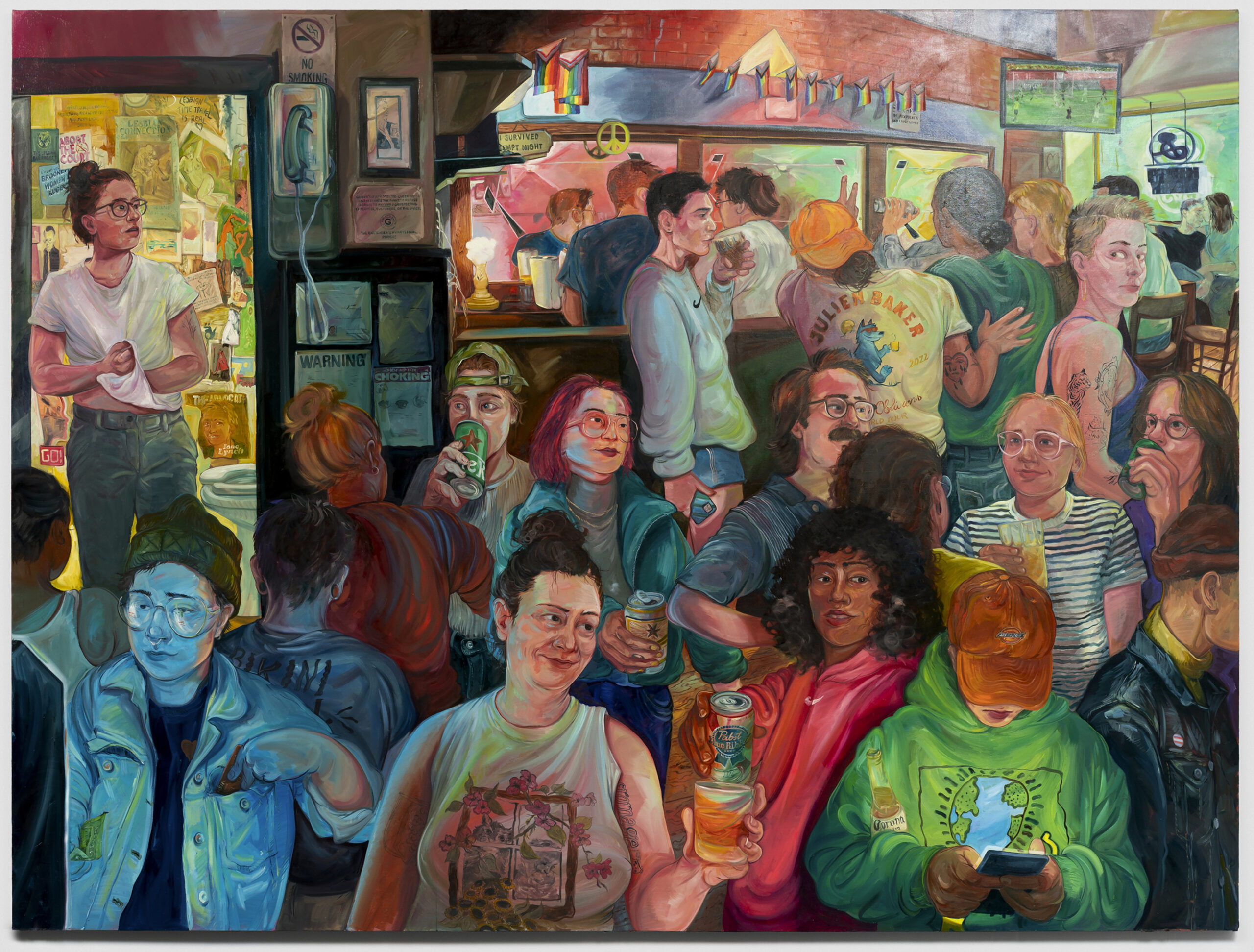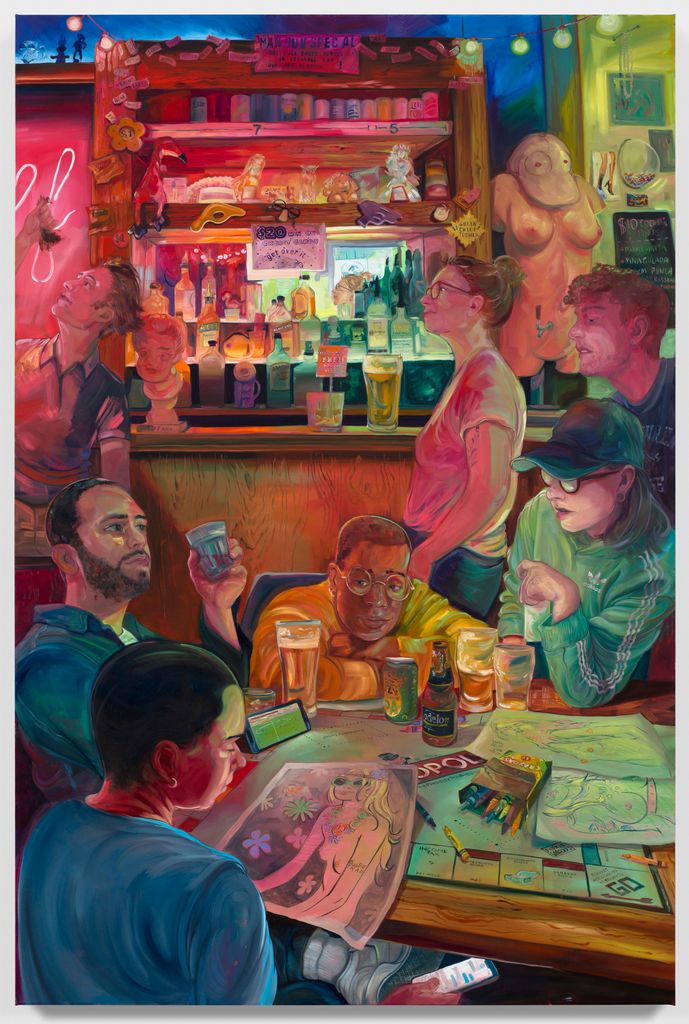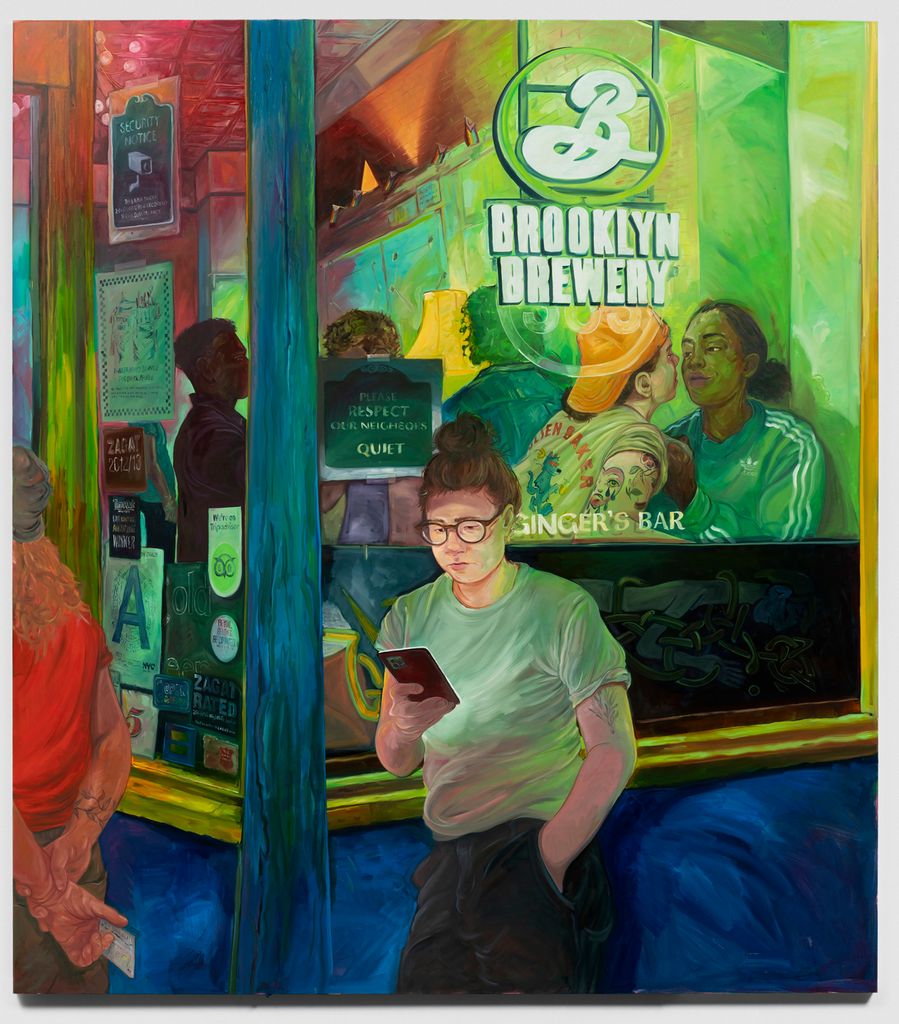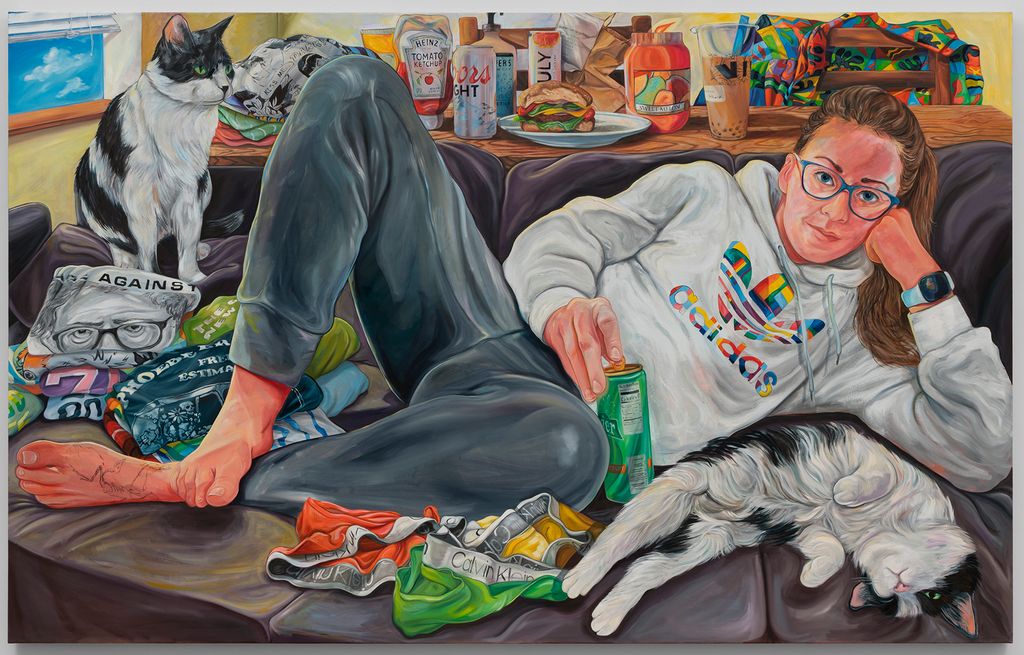Creating a Visual Diary
With a photographic eye, Rebecca Ness makes intimate, slice-of-life oil paintings of everyday moments

Heartbreak at Ginger’s: Re-emerging (2022) Oil on linen; 120 x 90 in. Photo by Philip Graysc, courtesy of the artist and Carl Kostyál London | Stockholm
Creating a Visual Diary
With a photographic eye, Rebecca Ness makes intimate, slice-of-life oil paintings of everyday moments
Rebecca Ness, a queer 30-year-old artist from Brooklyn, has no problem being compared to the 20th-century American painter Norman Rockwell.
“I am always confused when people ask what I feel about that,” says Ness (’15). “What’s not to like? I love illustration. I love American art. I love Rockwell deep in my heart.”
The associations with Rockwell abound for a reason: the scenes Ness paints seem as fleeting as those in candid photographs. Mundane moments—an artist friend’s face illuminated by a computer screen, a man looking up from his newspaper, a person holding a mug of coffee while flipping through a magazine—are lavished with attention, humor, and vibrant colors.


Left: Night out at Boobie Trap (2022) Oil on linen; 90 x 60 in. Photo by Lance Brewer, courtesy of the artist and Jessica Silverman Gallery
Right: Heartbreak at Ginger’s: Heading Out (2022) Oil on linen; 90 x 80 in. Photo by Philip Graysc, courtesy of the artist and Carl Kostyál London | Stockholm
The vivid-hued world Ness depicts in her paintings is hyperpersonal—bars populated with friends and acquaintances; a desk piled with loose papers, cups of coffee, and New Yorker magazines; a floor cluttered with squished tubes of paint and discarded bras. The energy in her compositions is palpable. Even inanimate objects refuse to lie still—pages curl, steam rises from coffee mugs. Her portrait subjects, many depicted from the neck down, fiddle with gloves and pencils, pointing their fingers and cracking their knuckles.
“I think I have a bit of a horror vacui with my work,” she admits, using the Latin term for an aversion to empty spaces. “I’m always packing in information.”
As a result, Ness’ works are a visual diary. The viewer follows her into subway cars, to friends’ studios, on camping trips and long nights out, seeing things the way she sees them, in ways that evoke exuberance, nostalgia, humor, and affection.
“A VERY SOCIAL WAY TO PAINT”
Ness began figure drawing and oil painting as an after-school student at the Acorn Gallery School of Art in Marblehead, Mass. Classes for youngsters at Acorn, Ness recalls, placed a special emphasis on learning the human form. “I learned very early on that there could be so much that you could say with a finger flick or a reflection in an eyeball.”
Painting people allows Ness to be a storyteller. In her crowd scenes—many of which were inspired by nights out at her favorite bar in Brooklyn, Ginger’s—patrons clamor for the viewer’s attention.
“The stories I tell are not always a piece-by-piece documentary of what really happened, but based on a spark of reality,” Ness says. “Maybe I included a story that my friend experienced with someone, but I don’t know what the other person looked like, so I invented them.”
In Ness’ Heartbreak at Ginger’s series, which she says was inspired by “an experience of unrequited lust,” the bar patrons scroll through iPhones, light cigarettes, wave to each other, and sip drinks. They wear their hearts on their sleeves, telepathizing their frustration, joy, and apprehension. Ness can usually be found in the corner.
“In those Ginger’s crowd paintings, there are probably 10 to 20 people that I just painted over, because I thought that they had a story but realized later, ‘Nah, this conversation is boring,’” she says. “It’s a very social way to paint, if you think about it. I have to spend time with these characters and see if I have any chemistry with them.”

Brainstorming (2019) Oil on canvas; 60 x 70 in. Photo by Jackie Furtado, courtesy of the artist
“WE ARE WHAT WE KEEP”
Not all of Ness’ paintings use human figures to tell stories. Much of her catalog could be classified as still life, and her inclusion of paintbrushes, newspapers, Dunkin’ cups, and other signs of life lend a human element to the space.
“We are what we keep, what we collect,” she says. “If I were to go to your house and look at your objects, I would probably have a really good idea of who you are.”
Ness is particularly fascinated with her own workspaces; they give her the opportunity to take snapshots of something messy and unfinished and include the tools involved in creating these works. In I See You, a riff on a self-portrait, Ness sits at a table in the bottom left corner, taking up about an eighth of the canvas. The majority of the work is devoted to her studio space—a tangle of extension cords snaking around art supplies, rough drafts, color test pages, canvases, art books, notepads, and a pair of orange Nikes.
“I think portraiture through objects is an interesting proposition,” Ness says. “My idea of a still life or a portrait is, ‘What’s on the floor?’”

My Life (2020) Oil on linen; 65 x 104 in. Photo by Prudence Cumming, courtesy of the artist and Carl Kostyál London | Stockholm
CRAFTING A SCENE
“I prefer to work from life, but I can’t really paint at a bar,” Ness jokes. In order to create a moment so personal it feels like a memory, she renders multiple photographs into a reference collage on her iPad.
“I find that it’s very streamlined to make the study on the iPad, and then do the drawing and invention on the canvas,” she says. “I don’t like to have everything planned out before, because then the painting isn’t fun.”
Much of her process is devoted to reexamining ordinary moments for new details. Works like Convening at the Table, Origins, Brainstorming, and Drawing Party represent a period of fascination with figures sitting at a table covered in newspapers, notepads, and art supplies. She painted each work from a different angle and made minor variations to the items on display. In earlier series, she depicted close-ups of friends reading books and newspapers or hands holding pencils and eyeglasses.
Ness’ subjects live in a Technicolor Brooklyn, where everyone is an artist and nobody keeps their room tidy. The more detail she includes—she uses oil-primed linen for its ability to capture fine detail “almost like paper”—the more her world comes into relief.
“I want to reward close looking,” she says. “I find that when you look closely at paintings, you look closely in other parts of life.”
Whether painting crowd scenes to tell a story or details to inspire a closer look, Ness is getting attention. She has been exhibiting since earning an MFA from Yale in 2019, landing coveted spots in prestigious art fairs including Art Basel Miami Beach, Art Cologne, and Frieze Los Angeles.
At the same time, she’s interested in experimenting with new subjects. In 2021, after a camping trip, she shifted briefly toward nature painting, filling her canvases with flower stalks and twisted tree bark in the same carefree disarray as the paintbrushes on a studio floor.
“It was really hard, and I did it because I felt that I was getting stuck in one language: and I don’t think that’s how you grow as an artist,” Ness says.
It’s helpful, she says, for her to look at each work as a short story. Since the misadventure at Ginger’s, Ness has been on a bar kick, and lately the short stories she’s committed to canvas have been about nights out at establishments like Boobie Trap in Bushwick and the East Village’s Lucien.
What comes after that all depends on what she gets up to next.
“The one thing that held Rockwell back was that he had to create this short communication for what was largely just white America,” she says. “I really differ in how much grace and freedom I have now.”